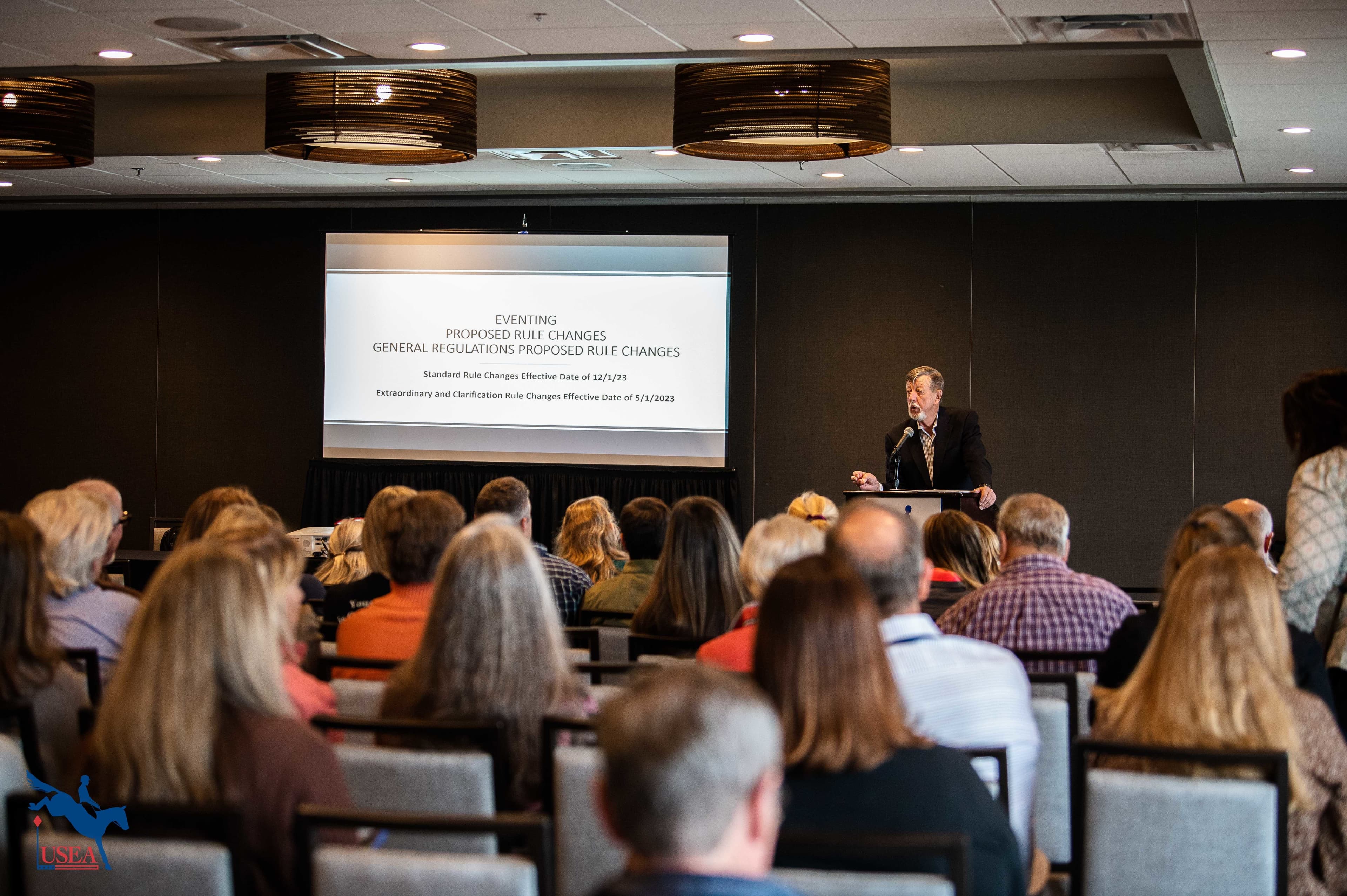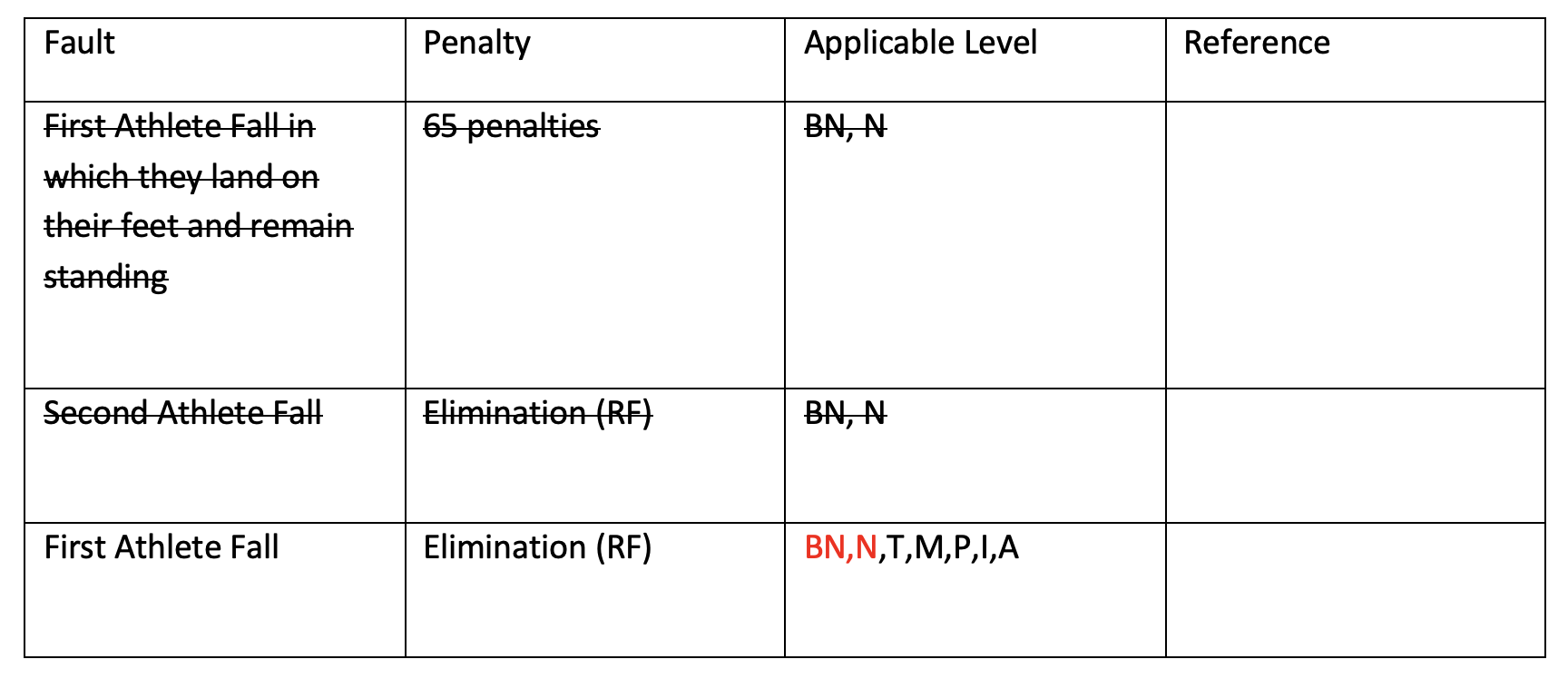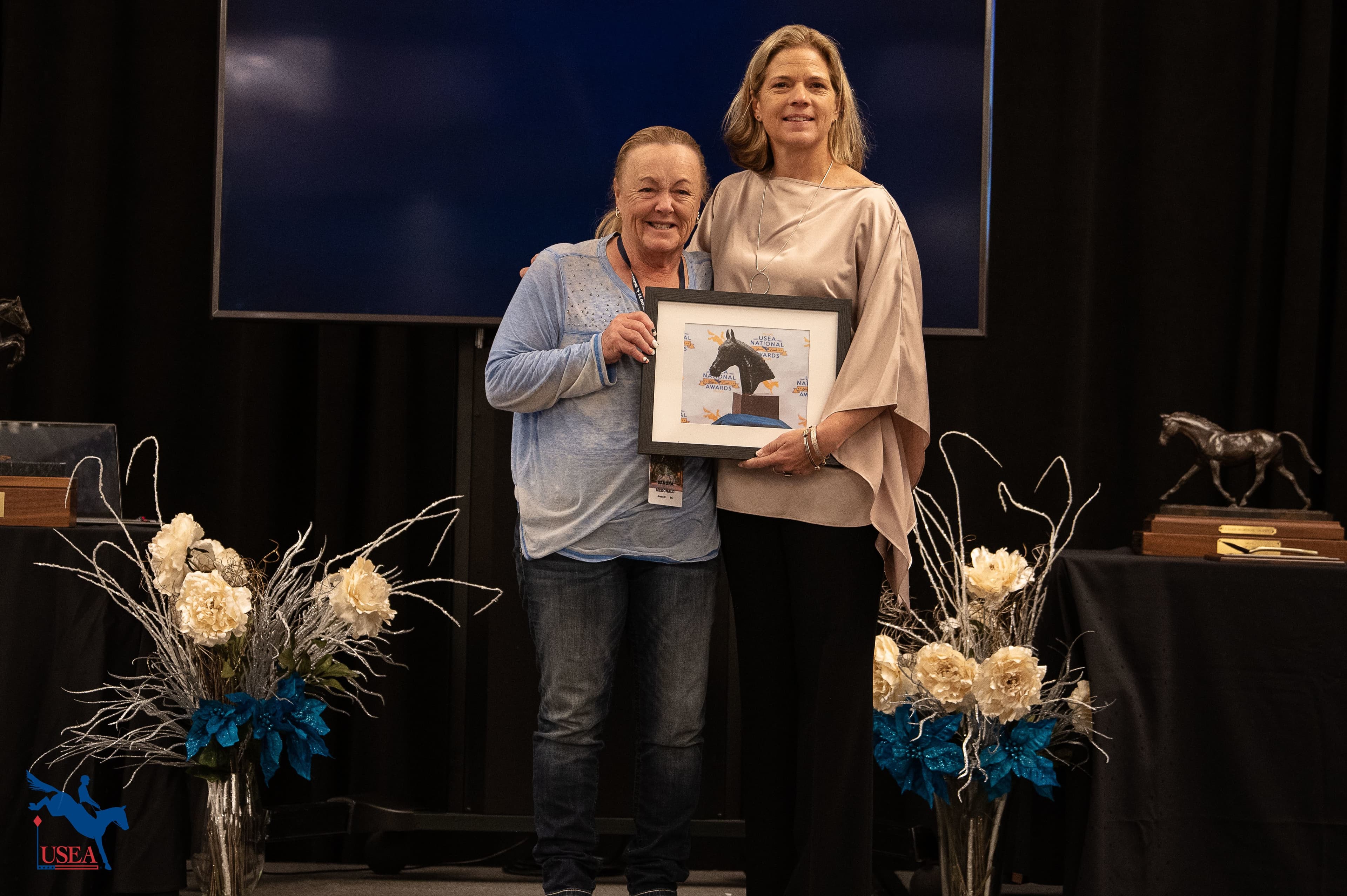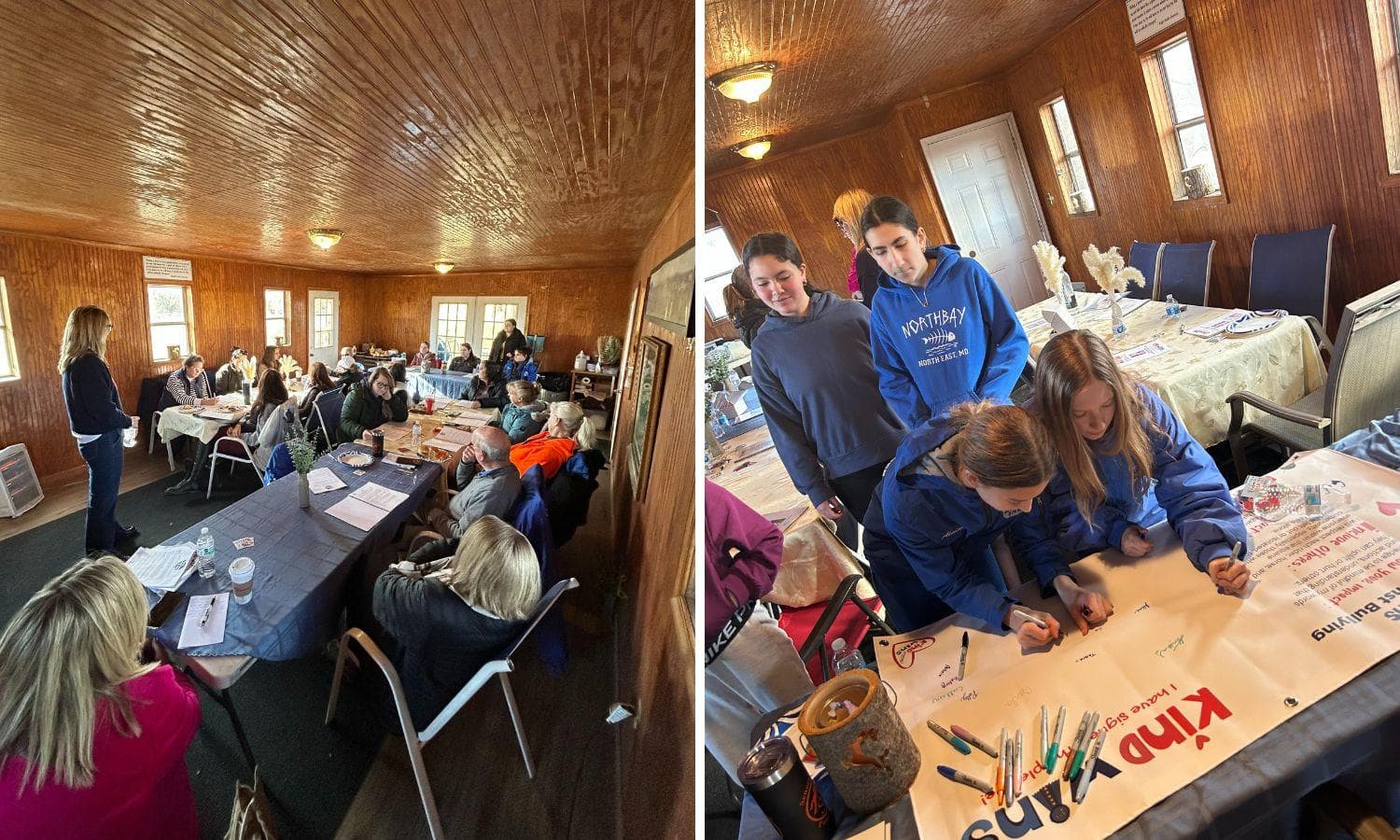Standard and Extraordinary Rule Change Proposals Presented at 2022 USEA Annual Meeting & Convention

The meeting room was full of eventing enthusiasts for the Rule Change Open Forum that took place on Saturday, December 10 during the 2022 Annual Meeting & Convention in Savannah, Georgia. Moderator Malcolm Hook outlined the 12 eventing-specific proposed rule changes and clarifications and 15 general rule changes which would impact eventing competitors which have not yet been approved by the United States Equestrian Federation (USEF). Throughout the session, Hook welcomed questions and feedback from forum attendees and encouraged USEA members to continue to send in their feedback via the rules feedback portal which will go live on Wednesday, December 14th on the USEA website.
Prior to launching into the rule change proposals, Hook noted that eventing competitors should familiarize themselves with the 2023 Rulebook which went into effect December 1, 2022, for the 2023 season. The 2023 Rulebook has been reformatted to be organized in a similar manner to the FEI chapters with rules divided into three categories: rules for the rider, rules for organizers, and rules for officials.
The following rule change proposals are extraordinary and would go into effect as early as May 1, 2023 if approved by the USEF.
The first of the rule change proposals relates to EV101 Introduction and was proposed by the USEA Classic Three-day Event Task Force. The intent of this rule change is to move the text related to Team competitions so it applies to all types of events, not just the horse trials. The language was also updated for clarity on the size of a team of three to four members.
One extraordinary rule change proposal being put forth before the USEA Board of Governors (BOG) is to EV122 Cross-Country Phase Definitions of Faults. This rule in its current form has been in existence as-is for 11 years of operation. The proposal is that falls will be counted anywhere on course, following the same criteria under which FEI competitions operate on. As previously written, falls only counted if the fall occurred during the jumping of an obstacle, but with this change falls would be considered a fall no matter where on course it occurred. Also, all falls at Beginner Novice and Novice would be penalized by elimination, where currently at those levels if the rider lands on their feet they assess 65 penalties but can mount up and continue on course.
The rule change language would read:
1. GENERAL. Faults (i.e., refusals, run-outs, and circles) must be penalized unless, in the opinion of the appointed personnel, they are clearly not connected with the negotiation or attempted negotiation of a numbered Obstacle or element. The negotiation or attempted negotiation of an Obstacle commences with the presentation of the Horse to the Obstacle. Falls will be penalized whenever they occur on course between the start flags and the finish line.

The changes to EV144 Cross-Country Phase Courses designate that at competitions where there is a long-format event in conjunction with a horse trial, it must be clear in the marking of cross-country fences which are long-format and which are standard horse trial fences in a similar capacity to what we do currently when a horse trial also runs FEI levels.
There was a proposed extraordinary rule change that would be an amendment to section 8 of EV145 Cross-Country Phase Obstacles outlining the requirement of frangible technology at the Training level.
a. Whenever possible, Obstacles for which frangible technology (e.g., frangible pins, MIM Clips, or any other load relieving device) is appropriate must be constructed or retrofitted with frangible technology for the Training level and above.
b. The Technical Delegate must confirm with the Ground Jury and Course Designer that the frangible technology employed is consistent with the USEA Cross-Country Obstacle Design Guidelines.
c. At a minimum, frangible technology devices used at national and FEI Events must meet the FEI Updated Standard for Frangible/Deformable Cross Country Fences Version 2 (April 6, 2020). As of January 1, 2021, all newly manufactured devices must be compliant with Version 2. Devices manufactured in accordance with Version 1, are no longer compliant as of December 31, 2021. Training fences constructed prior to May 1, 2023, may remain as such through December 31, 2023, but must be upgraded or retrofitted to meet this rule as of January 1, 2024. All fences constructed after May 1, 2023, must meet this rule.
The language changes in EV151 Classic Three-Day Event Rules do not offer substantial changes, just added specifications to section 3 regarding presentation and inspection of horses and section 5 regarding the length of course in Novice and Beginner Novice Three-day events.
The language changes for section 3 are outlined below:
3. INSPECTION & EXAMINATION OF HORSES.
a. Examination of the Horses takes place after they arrive but prior to the first Horse Inspection. The Inspection is performed by a veterinarian or delegate, appointed by the Organizer. The horse is presented in a halter by the Athlete or a designated Responsible Party. The object is to establish each Horse’s identity and state of health but not its soundness. The Organizer must determine the place and timetable for this examination in consultation with the veterinarian and inform the Athletes. Abnormal findings regarding the Horse’s identity of state of health must be report to the Ground Jury as soon as practicable and before the first Horse Inspection.
b. The first Horse Inspection takes place before the Dressage phase. It is conducted by the Ground Jury and a veterinarian. The President of the Ground Jury is in charge of this committee. The horses are presented by their respective Athlete in a bridle. Accommodations for an alternative handler of the horse may be granted by the ground jury should an athlete be unable to present their horse themselves. The Horses must be inspected in hand, at rest, and in movement on a firm, level, and clean but not slippery surface.
1. In a doubtful case the Ground Jury may put the Horse in question in a supervised holding area for examination by a veterinarian. Should the Athlete decide to represent the Horse, the holding area veterinarian shall report any findings to the Ground Jury and the head veterinarian prior to the horse being re-inspected by the committee.
2. The committee must Eliminate any Horse they judge is unfit, due to lameness, lack of condition, or for any other reason. In the event of a tied committee vote, the President of the Ground Jury will have a second vote, and the decision will be announced immediately.
c. Examination during the 10-minutes before the start of Phase D. It is conducted by a Ground Jury member and a veterinarian in a pre-defined area close to the start of Phase D. Expedient, but thorough inspections are ideal to allow Horses the maximum amount of time for recuperation. The committee must Eliminate any lame or exhausted Horse. At least one member of this committee should have participated at the first Horse Inspection. The Athlete’s welfare is also taken into consideration, the ground jury may eliminate from competition any rider they feel could be at personal risk to continue. In the event of a tied committee vote, a Ground Jury member will have a second vote.
The language changes for section 5 are outlined below:
5. TIME.
a. Time Limit – For Phases A and C, the Time Limit is one-fifth more than the Optimum Time. For Phase B, the Time Limit is twice the Optimum Time.
b. Time Faults:
1. Phases A and C, exceeding the Optimum Time is penalized 1 penalty point per second.
2. Phase B, exceeding the Optimum Time is penalized .8 penalty point per second.
3. Completing Phase B in less than the Speed Fault Time will be penalized in accordance with EV123.1 per Appendix 8 at .4 penalty point per second.
4. Phase D time faults are calculated per EV121,2 and EV213.
8. FAULTS. Except for Time Faults, described in EV151.5b above, Phases B and D use the same methodology for all other fault types. They are listed in EV121, EV122, and EV123.
The intent behind the changes proposed for Appendix 3 – Participation in Horse Trials are to align assumptions that a Classic is not a move-up, but rather more similar to the transition from a short to a long. The most common complaint was the difficulty to qualify for a three-day. The adjustments should reduce the burden and enable more riders to experience a USEA Classic Series event.
Under APPENDIX 8 - SPECIFICATIONS FOR THREE-DAY EVENTS, further clarification has been made to outline the standards at each level in each phase.
The following rule change proposals are considered standard rule changes and, if approved, would go into effect 12/1/2023. Commentary from members can be submitted from December 14, 2022 to January 9, 2023.
It was proposed that EV110 Entries be adjusted to exempt the USEA American Eventing Championships (AEC) from the 10-day qualification period prior to the start of the cross-country test of the competition for which it is needed. Due to the number of entries received for the AEC, the extra week permitted puts a strain on show personnel to process, verify entries, and notify waitlisted acceptance of entries, in a timely manner, to confirm transportation plans for those traveling a long distance.
There were some language clarifications and reorganizations in EV119.2,.3, and .4, but ultimately the rule will not change. The intent of this language adjustment is to clarify existing confusion among judges.
In EV136 Inspection of Courses, the rule change proposal would require cross-country Course Designers to visit the event site once every 12 months or after every third event, whichever would occur first.
There was a proposed extraordinary rule change that would be an amendment to EV145 Cross-Country Phase Obstacles. The amendment reads as follows:
e. Sloping & Round Leading Edges:
Spread fences including corners must not have an upright or vertical leading edge. The top of the front of the fence must be rounded or sloped. All other fences, including gates and fences using square and/or sawn materials, must not have any sharp or square edges. Brush fences are excluded provided there is at least 20cms of brush above the solid part of the fence.
Under the general rules, there are 15 proposals that will impact the eventing community. Brief descriptions of each general rule change proposals are outlined below:
GR302 License Application Policies and Procedures - General provisions around calendar modification approvals, currently organizers have 240 calendar days from the start of the competition to submit a request to add a level. The proposal would reduce that time to 60 days.
GR314 Mileage - The added language reads: “For Eventing competitions consisting exclusively of Showcases or Arena Eventing, there shall be no mileage.”
GR-801.2 Dress and EV114.1 Protective Headgear - Adds the Snell Memorial Foundation standards for equestrian use and carries the applicable certification label to the list of acceptable certified helmets for competition use to the currently acceptable ASTM and SEI approved helmets.
GR846.1 Safety Coordinator - Requires that the Safety Coordinator is a Senior Active member of the Federation.
GR846.2 Safety Coordinator - The intent of this rule is to specify that the Safety Coordinator or Management will notify the Stewards and Technical Delegates (TD) of an accident or injury to human or horse within an hour of its occurrence. Stewards and Technical Delegates are often elsewhere on the competition grounds when an accident or injury to a human or horse, or a collapse of a horse, occurs. Due to the Federation’s reporting requirements, notification to the Steward or TD by the Safety Coordinator or Management within one hour of its happening will enable the Steward or TD to report in the required amount of time.
GR846.6 Safety Coordinator - Currently the return to play rule required a release from a licensed physician, this language change adds in the authorization of a physician's assistant or nurse practitioner as an acceptable medical provider to who can release that rider to competition.
GR1021.1 General - Adds in a new class of Official titled the Equine Safety and Welfare Steward who will be licensed to officiate at Federation Licensed Competitions. The duties of the Equine Safety and Welfare Steward are outlined as follows in GR1037:
GR1037 Additional Duties of Equine Safety and Welfare Stewards
In addition to the responsibilities of a steward listed in GR1034, the powers, duties, and responsibilities of an Equine Safety and Welfare Steward are as follows:
1. Monitor the schooling, exercise, lunging, and stabling areas paying special attention to the safety of horses and riders, including but not limited to:
a. Overworking of horses;
b. Cruelty to and abuse of a horse (see GR838);
c. Overcrowding of the schooling, warm-up, and lunging areas;
d. In hunter, jumper, and equitation schooling, exercise, and lunging areas at Hunter/Jumper competitions: unsafe use of electronic devices (See HU Appendix A, JP103, EQ106);
e. Safeguard the welfare of the horse against violations of the Federation’s Drugs and Medications rules, and any of the Federation’s prohibited practices;
f. Ensure stabling, if provided, is in compliance with all applicable stabling rules; and
g. Report to the Competition Steward or Technical Delegate on violations of Federation rules.
GR1211 Appointment of Officials and Employees - States: Beginning December 1, 2024, at all Federation Licensed Competitions where the previous year’s entries were greater than five hundred (500) horses, an Equine Safety and Welfare Steward must be appointed. Beginning December 1, 2025, an Equine Safety and Welfare Steward must be appointed at all Federation Licensed Competitions.
GR1101 Horse Identification Number and Horse Identification Form - The change to this rule is as follows:
10. All horses competing at Federation Licensed Competitions must provide a microchip number that verifies the animal. A microchip used to verify identity must be a fifteen-digit ISO compliant 11784/11785 chip and be implanted in the nuchal ligament of the animal.
a. This rule will have a transition period from December 1, 2024 until November 30, 2025. During this period, animals that are not in compliance with this rule will not receive points or be eligible for Federation programs and awards. After this period, all horses that are competing in classes which require Federation registration, which are not microchipped will be ineligible to compete.
GR1214 - Results - Will result in a new requirement for organizers of an additional report after the competition delineating which judges officiated which levels and tests.
GR1215.3 - Stabling - Contains additional language as follows:
3. At competitions which offer overnight stabling, adequate lighting must be provided. Between the hours of 11:00 PM and 5:00 AM, of the time zone in which the competition is taking place, stabling must be dark and quiet to allow stabled horses a quiet period of rest daily.
About the USEA Annual Meeting & Convention
The USEA Annual Meeting & Convention takes place each December and brings together a large group of dedicated USEA members and supporters to discuss, learn, and enjoy being surrounded by other eventing enthusiasts. The USEA organizes multiple seminars in addition to committee meetings, open forums, and tons of fun! The 2022 USEA Annual Meeting & Convention took place at the Hyatt Regency Savannah Hotel in Savannah, Georgia, December 7-11, 2022. Click here to learn more about the USEA Annual Meeting & Convention.
The 2022 USEA Annual Meeting & Convention would not be possible without our wonderful sponsors! The USEA would like to thank the following sponsors for their support: Adequan, Bates Saddles, Capital Square, D. G. Stackhouse and Ellis, Gallops Saddlery, Grayson-Jockey Club Research Foundation, Kerrits, Mountain Horse, Nunn Finer, Nutrena, Parker Equine Insurance, Rebecca Farm, RevitaVet, SmartPak, Standlee and World Equestrian Brands.
Save the date for next year’s Convention in St. Louis, Missouri, December 6-10, 2023.














